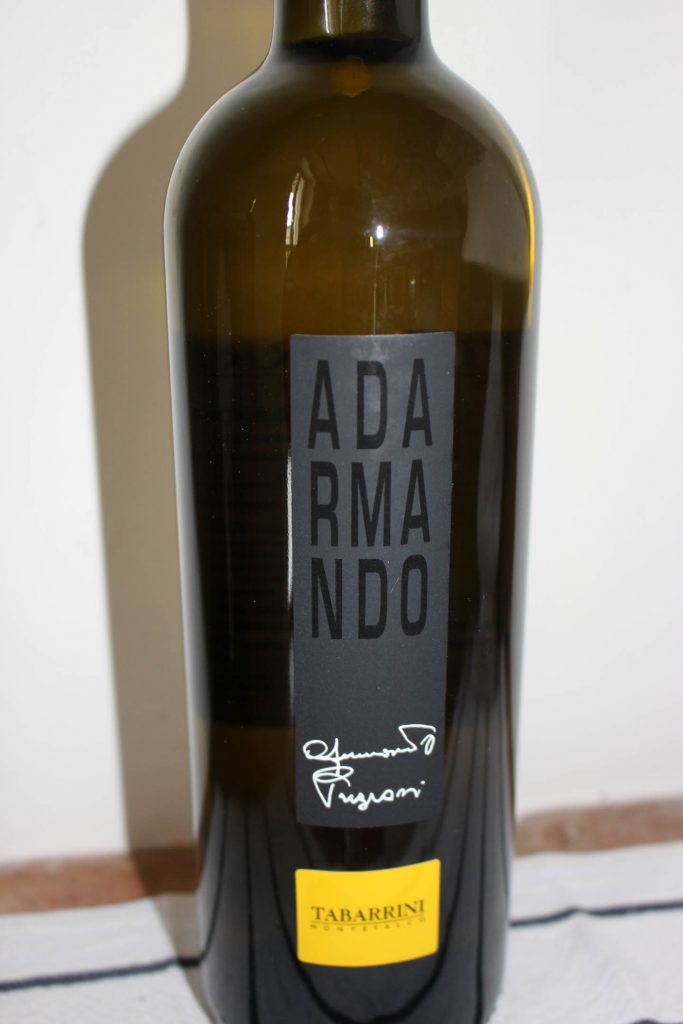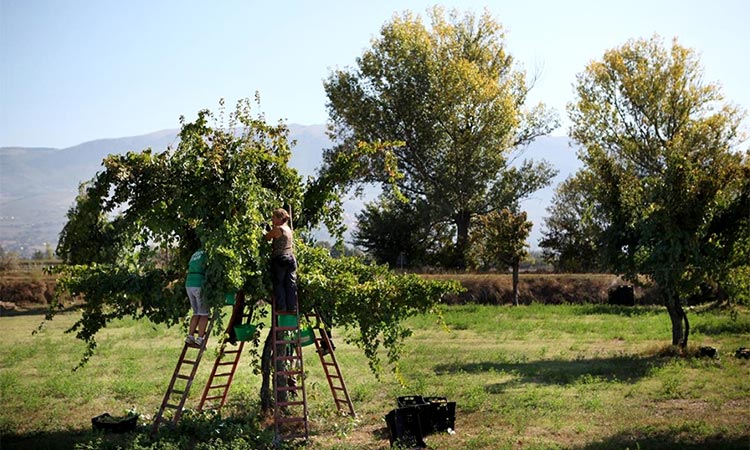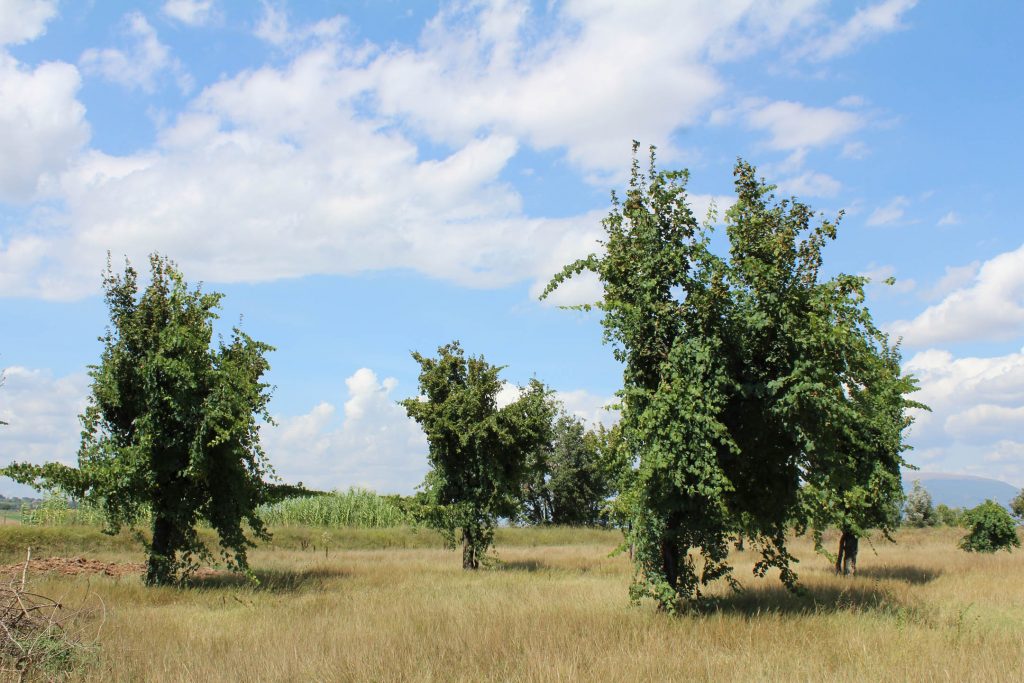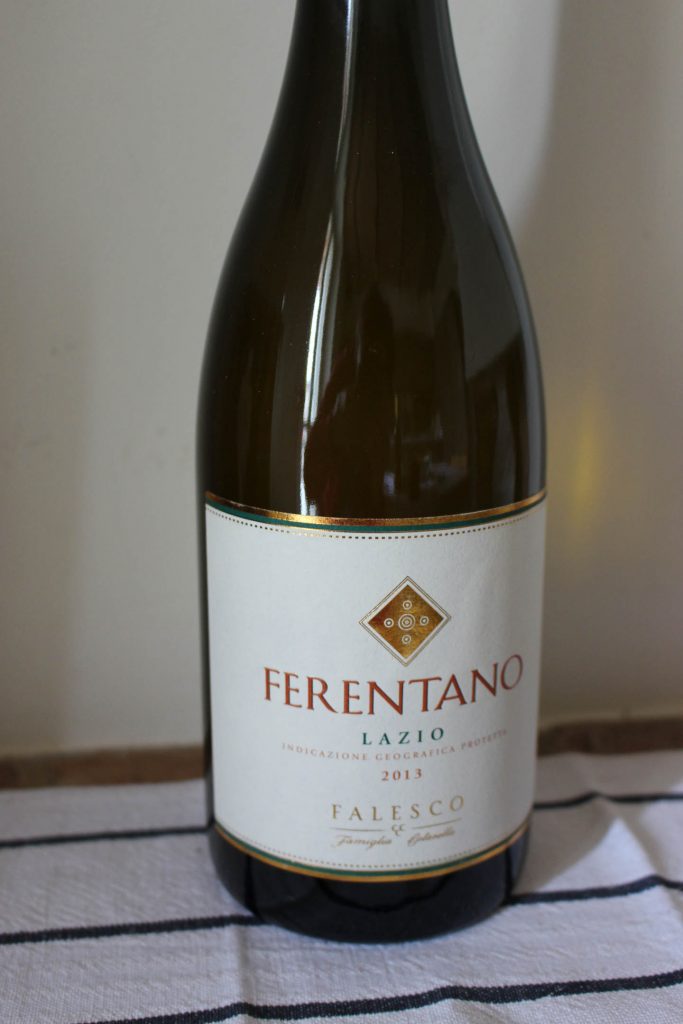Yes! It’s the Wine Guy with a new guest blog article for us.
~~~~~~~~~~~~~~~
Harvest Predictions and Two Interesting Recommendations
Like the cooling northern winds that are finally driving out the last of four hellish heat waves from north Africa, I’m back to talk a bit about the upcoming harvest and to tell you about two white wines I think you’ll find very interesting.
First, though, let’s talk about the weather: For those of you who haven’t been reading Nancy’s blog, and she knows who you are, we’ve been in the grips of an incredible drought here in central Italy. Until yesterday, September 1, we had not seen a substantial rainfall since April. Meanwhile, as I mentioned earlier, the country has been lashed by waves of heat from the north African desert sending temperatures above the 100 degrees Fahrenheit mark for literally weeks at a time. The situation became so bad that the reservoirs around Rome were reduced to literal mud flats, resulting in water rationing and shutting down of many of Rome’s fountains. On a recent trip to Sienna, we were shocked by the tilled-over fields, which had turned grey under the heat and resembled a moonscape. It is quite shocking to see a normally green landscape transformed so completely.
Normally, a long, dry summer would be desirable for the vintners, since the aridity and heat, concentrate the juice and produce a wine with amplified varietal character. There is usually a reduction in quantity, but it is offset by the increase in quality. Here, we may have had a little too much of a good thing; in fact, the latest estimates put the yield Umbria at around 60% of last year’s harvest, with Tuscany and the other central regions at about 70%. At these levels the juice produced may be so desiccated that the quality as well as the quantity of the wine produced could be seriously affected.
The first harvests in Umbria, sauvignon and chardonnay, have already started to come in and the results have been cautiously positive. In Orvieto, the yields have fallen by almost 50%(!), but the overall quality of the juice has been exceptional. The grechetto harvest took place last week with reports that there was little evidence of desiccation and that the bunches looked exceptionally healthy. Some growers in Orvieto are optimistically discussing a “vintage of the decade”, on a par with 2007, the last truly great vintage in Umbria. This may be a bit premature, as a key component of most wines from Orvieto, does not usually come in until early October. Time will tell.
The harvest here seems to move from the west to the east as the percentage of late ripening grapes is concentrated in the eastern areas around Montefalco. In between, we find Lago di Trasimeno, with a concentrations of both white and red wines. The whites, chardonnay and pinot bianco, are used to make a particularly fine metodo classico bollicine (can’t use that cham***ne word) that is treasured by the locals. There was considerable anxiety in July that the continuing heat wave could result in appassimento, the wilting of the vines in the heat. The white wine harvest, which began here August 18, turned out happily however, with expectations of grande qualità and reasonable yields. The early arriving red wines, gamay (yes, as in Beaujolais) and pinot noir, came in immediately after the whites. Again, the yield is down, although not so drastically as in Orvieto, and the quality is quite high. Perhaps the lake, second largest in Italy, exercised a moderating influence on the climate.
Finally, let’s turn to the Montefalco area. Here, the bunches are hanging heavily on the vines and the intense heat has caused the red wine grapes to change color early, which would usually indicate an early harvest, but appearances are misleading. In reality, the sugar content of the grapes is too low and the acidity is very high. This has producers looking at a more “usual” harvest in late September for the merlot and the sangiovese and October for the sagrantino and the trebbiano spoletino. The vintage is looking a little more promising as the heat has finally given way to cooler weather and thunderstorms and small rains have given the grapes a respite. I think that the words “cautiously optimistic” sum up the general situation. As I’m typing this, Nancy tells me there’s a whopper storm on the way. As long as it doesn’t turn into Harvey or Irma, that’s good news.
Just to round out the rest of the predictions: Tuscany is looking a lot like us, with limited yields and good quality. A little rain now would be a plus and it appears that they’re getting it. The Veneto, where most prosecco comes from, has been a disaster, with mudslides throughout the spring and alternating rain and high heat. The mudslides appear to have been made worse by overplanting. Prosecco is the drink du jour in Europe right now, so the wine producers are planting like mad. I have a bad feeling that by the time the vines really begin to produce, the world will have moved on, and the Veneto will find itself with tons of unsellable prosecco. Maybe not, such is the life of the producer.
The rest of Italy is looking at a nice harvest. The kind of hot weather we’ve been experiencing is par for the course in the south with the exception of western Sicily, known for a grape called grillo not seen very much in the USA, but the main component of Marsala wine. Keep your eyes out for nero d’avola (red) from Sicily, Fiano di Avellino and Grecho di Tufa (whites) from Campania and primitivo and aglianico from Puglia. They should be great and the costs, even with the dollar down almost 20%, should be good.
A Couple of Interesting White Wines
Finally, I’d like to tell you about two white Italian wines I’ve discovered with these interesting characteristics: (1) You can find them in the US; and (2) They exhibit a good aging(!) potential.

The first wine is from a local Umbrian grape, trebbiano spoletino. It’s a low-yielding local variant of trebbiano that, in its native state, grows in trees. It is well known as a “neighborhood” wine: that is, its only production was by families willing to invest the labor necessary to cultivate the vines. Real winemaking businesses were not particularly interested for many years and it remained a local curiosity. Trebbiano spoletino has become a sort of boutique wine in recent years and there are now several relatively large producers who cultivate it in the standard posts and wire method. However, there is one winemaker, Tabarrini, who produces trebbiano spoletino from 60 year old vines in the traditional way, cultivating the grapes in trees. They do this today as an homage to one of the original founders of the vineyards, Armando, who was one of the first to recognize the value of the grape here and, according to his grandson, took a particular delight in going up and down the ladders at harvest time. The wine, Adarmando (to Armando) preserves his name. I’ve included a couple of photos to give you a feel for what the grapes and the harvesting process look like.

Photo courtesy of Tabarrini vineyards

Photo courtesy of Tabarrini vineyards
At our last visit to Tabarrini, we were offered several older vintages, 2009 and 2010, and invited to compare them against the current 2015 release. We were pleasantly surprised. The 2015 vintage is quite good, with good minerality and overtones of fresh fruit. In the mouth, it has a distinctive character, unlike many whites, which just come across as a bit liquid. The previous vintages exhibited these qualities, but in a rarefied way, with a softness and additional depth of character that was quite surprising. I wouldn’t argue with anyone who wants to drink the 2015 now, it’s delicious, but the aging did seem to transform it to a higher plane. I decided to play my cards straight down the middle and bought a batch for now and a batch to go down. I don’t see it going more than five or six years, but I think those who wait will be rewarded. You can order the wine from www.tabarrini.us at $19.43 a bottle plus shipping. It’s available at some restaurants in the Washington, New York and San Francisco areas and at some specialty wine stores, but with a production of only 8,000 bottles a year it is probably going to be a bit hard to find.
For those of you who want the gory details, the grapes are grown at about 1000 feet in silty, clay soil and harvested in mid-October, unusually late for a white wine, but typical for this varietal. It spends twelve months in stainless steel tanks on the lees, meaning the left-over yeast particles from the fermentation are left in the tank. This imparts what is usually described as a creamier, richer flavor to the wine and adds complexity. After the fermentation the wine undergoes six additional months of bottle aging before release. A considerable amount of work for a white wine, but worth the effort.
 Exhibit number two comes from just a bit south of the Tuscan border with Lazio, from the producer Falesco. Falesco is a major producer, nearly 3 million bottles, from 370 acres of vineyards in Lazio and Umbria. Falesco is best known for its monster merlot, Montiano, which is widely available in the US–I’ve seen it at Total Wine in the Washington DC area. It also produces a cheap local style wine with the cute name “Est! Est!! Est!!! di Montefiascone”. Mark Twain once remarked that Wagner’s music was “better than it sounded”. In the case of “Est! Est!! Est!!!” (Est! = it is!) the name is better than the wine–give this one a miss. But I digress.
Exhibit number two comes from just a bit south of the Tuscan border with Lazio, from the producer Falesco. Falesco is a major producer, nearly 3 million bottles, from 370 acres of vineyards in Lazio and Umbria. Falesco is best known for its monster merlot, Montiano, which is widely available in the US–I’ve seen it at Total Wine in the Washington DC area. It also produces a cheap local style wine with the cute name “Est! Est!! Est!!! di Montefiascone”. Mark Twain once remarked that Wagner’s music was “better than it sounded”. In the case of “Est! Est!! Est!!!” (Est! = it is!) the name is better than the wine–give this one a miss. But I digress.
The head of Falesco, Riccardo Cotarella, prides himself on discovering and preserving ancient, indigenous wines from extinction. One of his most notable finds was roscetto, a varietal found near the ancient Etruscan town of Ferento, from which it takes its name, Ferentano. Like trebbiano spoletino, roscetto is a late maturing (late September), low yielding grape with good sugar content and aromas.
We had the good fortune to discover the aging potential of roscetto at restaurant Pascucci al Porticciolo, a fantastic fish restaurant with an attached hotel of the same name but under different management about a 20 minute cab ride from Rome’s airport–secret tip: go there!. The restaurant feature vintages of Ferentano going back to 2004 and we tried two. They were amazing. As with the Adarmando, let’s talk about the latest vintage first, the 2016. It has a beautiful golden hue with roseate tinges, reflecting the results of the dry ice process used during maceration. The wine, which sees four months in barriques, small (250 liter) wooden barrels, shows a buttery taste reminiscent of good chardonnay. The taste is forward, with lots of fruit and a lingering finish. There is a bit of tannin on the mouth, due to the oak aging, but it’s not unpleasant. The older vintages show these qualities in a softer and more multi-layered way. It’s not like the aging of sagrantino, which turns pit bull tannins into lap dog esters; it’s more subtle than that. But the tannin has been tamed and once again, you see a softer, rounder result with many dimensions, not a normal quality in anything but the best white wines.
For the technically interested: Riccardo Cotarella has said that his goal was to emphasize the varietal characteristics of the roscetto grape. To achieve this, he developed a process using dry ice(!) during maceration, the time when the tannins, coloring agents and flavor compounds—are leached from the grape skins, seeds and stems into the freshly pressed juice. This is carried out in stainless steel vats over a period of four months. Following that, the wine sees four months in maleolactic fermentation in barriques, a process usually reserved for the better reds and fine chardonnays. The maleolactic fermentation imparts a buttery quality to the wine. The use of barriques imparts a subtle oak feel reminiscent of French chardonnays.
Next Time
Nancy has shamed me into resuming my writing. To make sure I continue, I’m going to tell you what I’m planning next, just to keep me doing more writing and less drinking, the latter of which I think I’m much better at. In any case, next time we’re going to visit Puglia, one of the little known jewels of Italian winemaking. If you think Puglia is just a sort of Italian zinfandel, you’ve got a surprise coming.
Salute!
